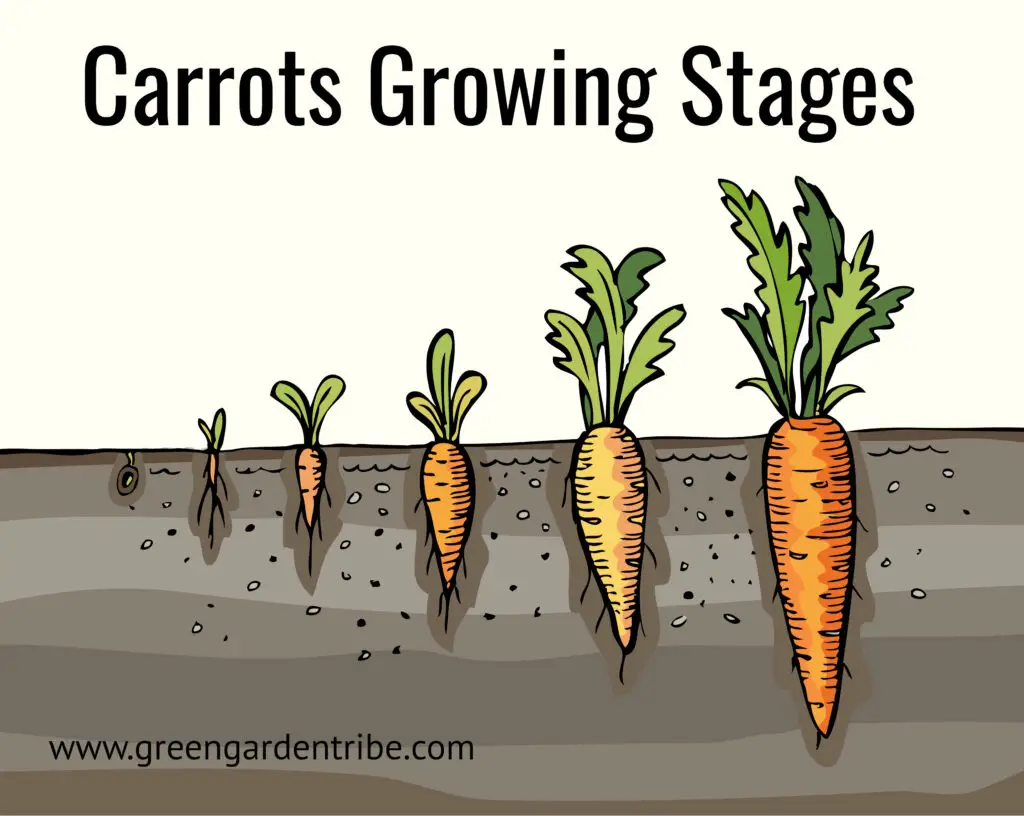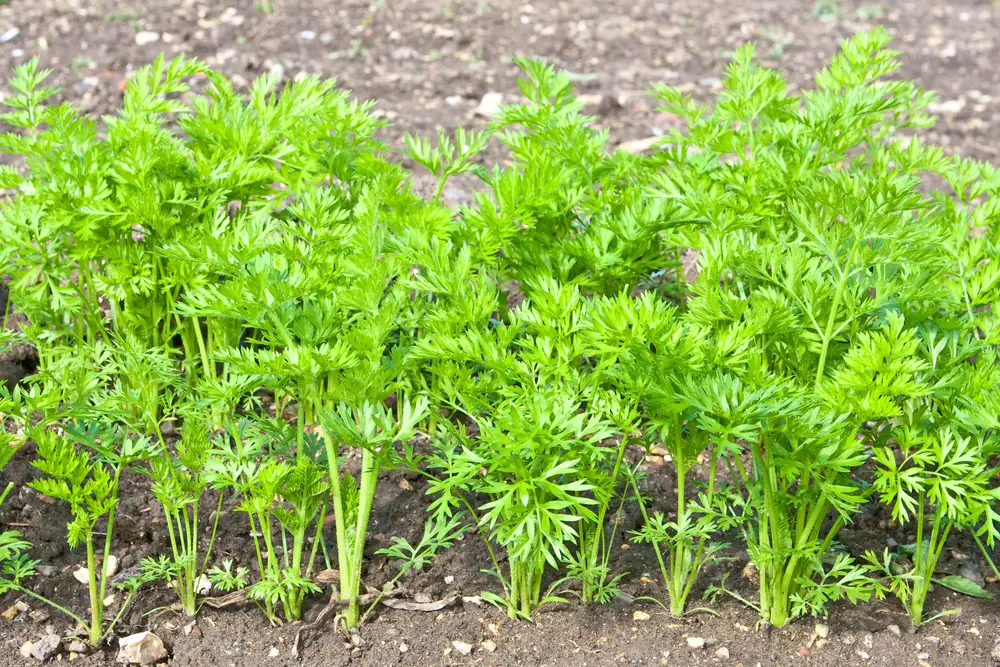Carrot is an easy crop to grow in your garden.
The two growing stages of carrots are Season 1: Planting, Germination, Vegetative State, Lengthening of Taproot, Formation of 3rd True Leaf, Tuber expansion, Harvest time, Frost. Season 2: Flowering Stem, Umbel Development, Seed formation, Senescence.
Carrots Growing Stages
Knowing the carrots growing stages is crucial to ensure a healthy harvest.
Carrots are biennials, so they have two planting seasons from the planting stage to the harvest stage.
First Season of Growing Carrots
During the first season, carrot growth is focused on the growth of the tops and the development of tubers.
Planting of Carrots
Carrot is a cool-season vegetable so it will germinate and grow at a lower temperature.
It is best to plant your carrots in early spring so you can harvest in summer. You can opt to plant later and have a fall harvest.
If you are going for a summer harvest, it is best to sow outdoors about three to five weeks before the last spring frost.
If you want an autumn harvest, plant your carrots in the mid to late summer or about 10 weeks before early summer.
Sow new seeds every three weeks in late spring to ensure you have a continuous harvest.
Germination of Carrots
When you notice young seedlings appearing and developing their root system, your plant will start to find water in the depth.
At this point, you do not need to water your plant unless the soil dried out or the tops appear weak.
The appearance of the primary root (radicle) is the first step in germination. Carrot roots secure your plant in the soil.
The radicle is the first root of the carrot plant to start absorbing nutrients and soil moisture.
A shoot forms from the seed after the roots begin to absorb moisture. Sprouts start to grow upward and appear from the soil in the direction of the sunlight.
Vegetative Stage of Carrots
Carrot growth is slow at this stage. The plant still relies on its stored food for all its metabolic processes. These stored foods are, however, starting to dwindle.
At this stage, the large, central root form (taproot)and secondary roots start to develop. The taproot stores food that is necessary for the growth of the carrots.
It is also at this stage that the first true leaf of your carrot plant appears, looking like small mature leaves. Photosynthesis then begins and the plant can produce its food.
Lengthening and Expanding of the Taproot
The growth of your carrots starts to thicken during photosynthesis. The taproot starts to grow deep into the soil where it can better access the root zone for nutrients and moisture.
At this point, the taproot begins to expand in width.
It is at this stage where your carrots will benefit from proper soil preparation before the planting.
If the taproot gets into contact with hardpans, rocks, or other layers it cannot penetrate, it will deform instead of growing straight down because it will have to avoid the obstacles.
At this stage, your plant will need a fertilizer with high levels of potassium and phosphorous to encourage the growth of its roots.
Formation of Third True Leaf
Your carrot plant is now growing at speedy pace. Phytohormones (hormones within the plant) continue to work double-time to develop new leaves.
The third set of true leaves will begin to form to enhance photosynthesis.
Tuber Expansion
Your carrot tops are now filling out and the sun helps in the production of glucose within the leaves. Glucose begins to gather in the tuber while continuing to power the cellular growth processes.
You will have to consistently water the soil, so your carrots do not crack. At this stage, a portion of the “shoulders” of the carrots is starting to protrude from the surface of the soil.
Carrots – Harvest Time
You are now ready to harvest your carrots. This is about 75 to 80 days after planting.
You can consider this stage as the end of the life cycle of your carrot plant because you have pulled the crops from the ground.
But if you leave the plant in the soil, your plant will go on through its second growth season and reach full maturity.
Frost
During frost, water within the carrot sells will freeze and break the cell walls. The tops will die, too.
Season 2 of Growing Carrots

It is common for gardeners to not let their carrots go through the second season. Some, though, allow their plants to seed.
Making your plant overwinter in the ground allows them to grow again the following spring to set seeds and eventually complete their life cycle.
Flowering Stem
As the temperature rises, the cells of your plant will start to elongate (like when it first germinated) and the root system develop.
Your plant will now focus on forming a shoot. As the shoot ages, it will become a flowering stem.
Development of Umbels
In early summer, your carrot plants will rapidly shoot up stems (bolting process). Your plant will bolt to produce seeds toward the end of its life cycle.
The umbels will then start to develop and will become the seed heads.
Seed Formation
At this stage, all the food produced by your plant will be redirected from the carrots and will be utilized for seed formation. The tubers at this point will be fibrous and woody.
Senescence
Your plant will no longer need to grow once it has formed seeds. This is when its life cycle is complete.
After diverting all its energy to form seeds, your plant no longer needs further growth.
Phythohormones promote senescence (deterioration due to age) causing your plant to die.
Description
Carrots (Daucus carota subsp. sativus) are biennials often grown in USDA hardiness zones 2-11.
It takes about 50 to 80 days for carrots to mature and be harvested , depending on the cultivar.
Carrots are rich in Vitamin A. They add a lot of color to your meal. They can be served raw or cooked.
They can be eaten by themselves (carrot sticks with dips) or as an ingredient in your dishes or salads.
Growing Requirements of Carrots
Choosing where to Grow. You can grow your carrots in pots or garden beds.
Soil Requirement. Carrots thrive in well-draining, loose, sandy loam soils. They will mature slowly when planted in heavy soils and will have unattractive and rough roots.
Soil Temperature. Day temperatures of 750 and night temperatures of 550. High temperatures will cause poor-quality and poor-colored carrots.
Sun Requirement. Full sun. When planted in raised beds, neighboring plants can provide some shade.
Watering. Keep soil moist – about 3 inches deep of water.
Fertilizing. Spread 1 cup of complete fertilizer (10-10-10) on the soil before planting and once the plant starts to emerge.
Final Thoughts on the Growing Stages of Carrots
Carrots are biennial plants. However, they are often grown and harvested as annual plants.
Being a biennial, it takes two years for your carrot plant to complete its life cycle.
Biennial growth is a technique plants have made so they can grow in areas where growing seasons are typically shorter.
Now that you understand the carrots growing stages, you are ensured of a good harvest because you know how to care for your plant at every stage.
The question now is, will you end the life cycle of your carrots after harvesting or should you go ahead with Season 2?
We think carrots are so delicious we’d be testing to create a 3rd season! Enjoy!!!
Jenny Marie
Tribal Writer
Edited By
Patricia Godwin

